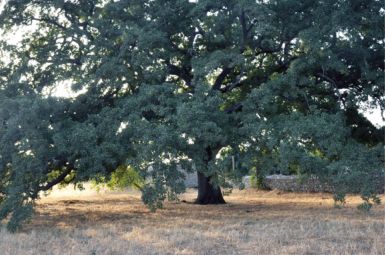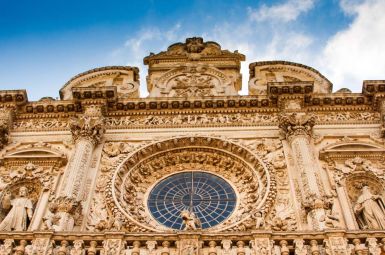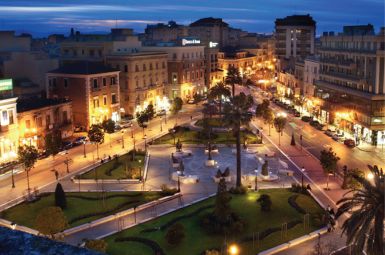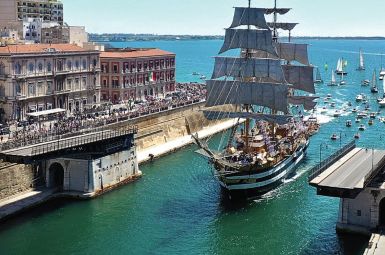
Sant’Agata De’ Goti
Il Borgo di Sant’Agata De’ Goti
Sant’Agata de’ Goti: La Perla del Sannio Sospesa sul Tufo
Sant’Agata de’ Goti non è solo un borgo, ma una visione che sfida la gravità. Incastonato nel cuore della Campania, a cavallo tra il Sannio e la Valle Caudina, questo gioiello fa parte del circuito dei Borghi più Belli d’Italia e vanta il prestigioso riconoscimento di Bandiera Arancione del Touring Club Italiano. La sua posizione unica, a picco su un’imponente terrazza di tufo delimitata dalle gole profonde dei fiumi Riello e Martorano, regala un panorama mozzafiato, soprattutto all’imbrunire, quando le luci ne disegnano il profilo antico come in un quadro d’altri tempi.L’Architettura che Racconta la Storia
Il centro storico, sorto sull’antica città sannitica di Saticula, è un’elegante passeggiata lunga circa un chilometro, Via Roma, che si snoda tra un patrimonio storico-architettonico straordinario:- Il Castello Ducale: Fondato dai Longobardi, questo imponente maniero in tufo giallo è stato il cuore del potere feudale, passando per i Normanni (i Drengot, da cui “de’ Goti”) fino ai D’Angiò e ai Carafa.
- Patrimonio di Fede: Il borgo è un vero e proprio “museo a cielo aperto” per la quantità di chiese ricche di arte. Imperdibile è la Chiesa di San Menna, la più antica del borgo, risalente al VI secolo, che custodisce un magnifico pavimento a mosaico cosmatesco, tra i più antichi e significativi del Sud Italia. Altrettanto rilevante è la Cattedrale dell’Assunta, che cela una suggestiva cripta medievale.
- Luoghi Alfonsiani: Sant’Agata è profondamente legata alla figura di Sant’Alfonso Maria de’ Liguori, che fu Vescovo della diocesi. I luoghi alfonsiani, tra cui il Museo Diocesano e il complesso delle Redentoriste, testimoniano il suo operato e la sua eredità spirituale.
Il Gusto di un Territorio Unico
L’eccellenza di Sant’Agata de’ Goti prosegue a tavola, in una terra che è Città del Vino e Città della Nocciola.- Vini Pregiati: Le colline pedemontane del Monte Taburno sono la culla di vini campani di alta qualità. Qui si producono la rinomata Falanghina e l’Aglianico, nettari che esaltano il legame indissolubile tra il tufo vulcanico e l’uva.
- Sapori Certificati: La zona è famosa per la produzione della pregiata Mela Annurca I.G.P. e del Tartufo Nero, elementi che arricchiscono una tradizione culinaria semplice ma raffinata.
Eventi di Colore
Ogni anno, l’antica devozione popolare si trasforma in un evento di impareggiabile bellezza: l’Infiorata del Corpus Domini. Le strade del centro storico si vestono di mosaici e tappeti floreali, realizzati con maestria e passione, attirando visitatori da ogni dove e trasformando il borgo in una fiaba colorata e profumata. Sant’Agata de’ Goti è la sintesi perfetta tra l’imponenza della natura e la delicatezza dell’arte, un’esperienza sensoriale e storica da vivere in ogni suo suggestivo vicolo.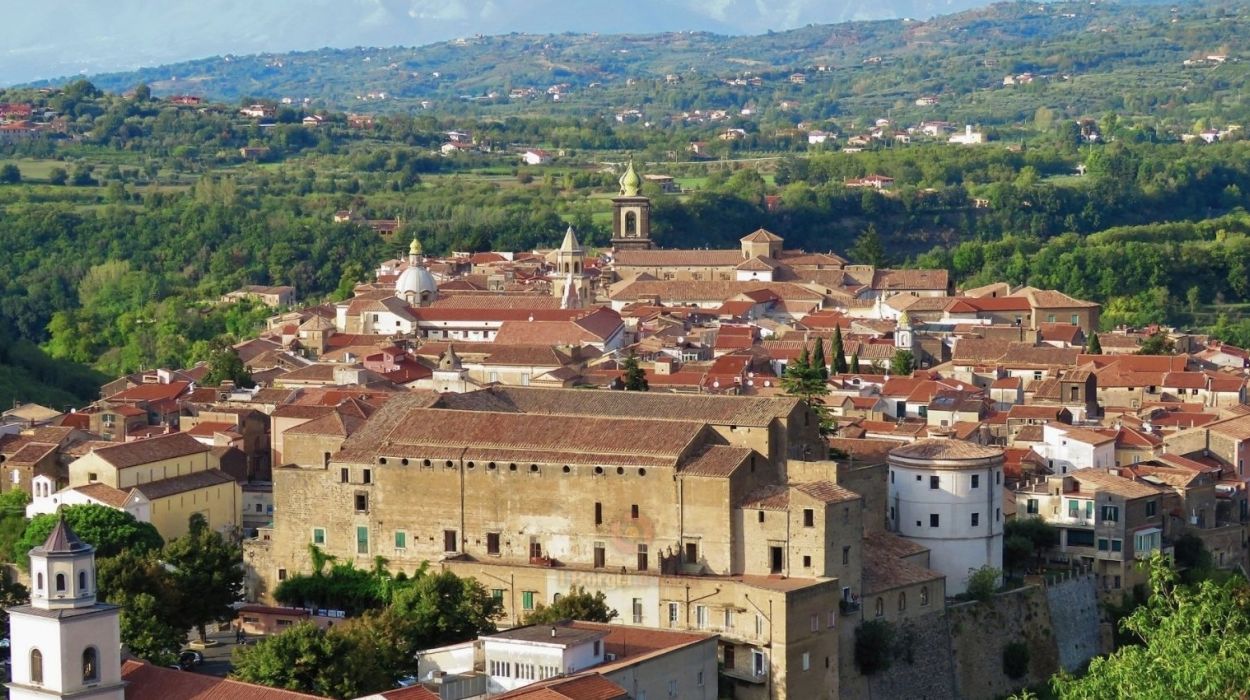
Il Borgo d’Italia
tutto da scoprire ed esplorare
Monumenti
SANT’AGATA DE’ GOTI: L’ARCHITETTURA SOSPIRATA TRA STORIA E TUFO
Sant’Agata de’ Goti, annoverato tra i Borghi più Belli d’Italia, si erge maestoso su una rupe di tufo, letteralmente sospeso sulla forra scavata dai torrenti Martorano e Riello. La sua bellezza non risiede solo nel panorama mozzafiato, ma in un patrimonio monumentale che narra secoli di storia, dai Sanniti ai Longobardi, dai Normanni all’opulenza barocca.
Il Castello Ducale: Fortezza e Dimora Nobile
Dominando la città dall’alto, il Castello Ducale (noto anche come Palazzo Ducale) è la prima sentinella della storia cittadina.
- Dalle Origini Longobarde al Settecento: Sorto originariamente come fortificazione in epoca Longobarda, fu ampliato dai Normanni (intorno al 1066) in un fortellicium. Nel corso dei secoli, fu la residenza di importanti famiglie feudali, tra cui i D’Angiò e i Carafa, che lo trasformarono da fortezza militare in una prestigiosa residenza nobiliare.
- Tesori Nascosti: Nonostante sia oggi in gran parte frazionato in proprietà private, il castello conserva al suo interno tracce di grande valore, come i cicli di affreschi del pittore settecentesco Tommaso Giaquinto in alcuni saloni, testimoni dell’epoca di massimo splendore.
Il Duomo (Concattedrale dell’Assunta): Dalle Origini Romaniche al Barocco
La principale chiesa della città è un palinsesto di stili che ripercorre l’intera storia medievale e moderna del borgo.
- Un Monumento Nazionale Stratificato: Fondato nel 970 dal vescovo-conte Madelfrido, l’edificio fu ricostruito nel XIII secolo e pesantemente restaurato dopo il devastante terremoto del 1688, assumendo l’attuale veste Barocca. Il grande atrio porticato esterno funge da imponente cesura urbanistica.
- La Cripta Romanica: Il cuore storico del Duomo si trova sottoterra: la Cripta Romanica (fine XI secolo) è giunta intatta fino a noi. Le sue volte a crociera poggiano su colonne e capitelli di spoglio provenienti da edifici romani, bizantini, longobardi e normanni, creando un affascinante museo sotterraneo.
- Mosaici e Intagli: Al suo interno, si possono ammirare raffinati elementi barocchi, marmi bicromi e, in corrispondenza del presbiterio, frammenti di un mosaico pavimentale del XIII secolo, di grande importanza per l’Italia meridionale.
Chiesa di San Menna: Il Gioiello Musivo
Considerata la chiesa più antica del borgo, la Chiesa di San Menna è un piccolo gioiello architettonico che fu un tempo la cappella del castello.
- Il Mosaico Cosmatesco: La sua principale attrattiva è il pavimento musivo in stile cosmatesco, risalente al XII secolo e riconosciuto come tra i più antichi di tutta la Campania. Questo mosaico è un raro esempio di arte medievale che unisce elementi geometrici e simbolici.
La Gola e il Ponte sul Martorano: L’Affaccio Sulla Storia
Il monumento più suggestivo di Sant’Agata non è un edificio, ma il suo scenario naturale visto da un punto preciso.
- La Vista Iconica: Dalle strade che conducono verso il Ponte sul Torrente Martorano (come il Ponte Vittorio Emanuele o il Belvedere), si può ammirare l’immagine iconica di Sant’Agata de’ Goti: il borgo intero, con le sue case in tufo giallo, arroccato a strapiombo sul costone roccioso, in un’immagine che richiama la bellezza di un paesaggio uscito da un romanzo fantasy. L’antico borgo, illuminato di notte, offre uno spettacolo di rara suggestione e immortalità.
I Portici di Sant’Alfonso
Un’altra caratteristica architettonica distintiva è legata a uno dei suoi più illustri vescovi: Sant’Alfonso Maria de’ Liguori.
- L’Impronta di un Santo: I Portici di Sant’Alfonso sono una sequenza di logge in pietra che un tempo facevano parte del complesso monastico delle suore Redentoriste. Voluti dal Santo Vescovo, questi portici creano un percorso suggestivo nel centro storico, con le botteghe e le attività che oggi occupano quelle che anticamente erano le celle di clausura delle religiose.
Curiosità
SANT’AGATA DE’ GOTI: L’ENIGMA SOSPESO TRA LE ROCCE E LA GRANDEZZA STORICA
Sant’Agata de’ Goti non è semplicemente un borgo; è una narrazione architettonica, un luogo dove la storia, la leggenda e la geologia si fondono, offrendo un’esperienza unica e irripetibile. Ecco le curiosità che la rendono una delle “Perle del Sannio”.
Il Mistero del Nome: Loti, Goti o Drengot?
Il cognome storico della città, “De’ Goti”, è avvolto in diverse ipotesi affascinanti, tutte legate alla sua profonda radice storica.
- L’Impronta dei Guerrieri: L’ipotesi più diffusa e romantica lega il nome a una colonia di guerrieri Goti. Questi soldati, sopravvissuti alla sconfitta di Totila nel 553 d.C., si sarebbero insediati nella zona sotto l’Impero, lasciando il loro segno nel toponimo.
- La Trasformazione Normanna: Un’altra teoria rimanda alla potente famiglia Normanna dei Drengot, che dominò il feudo a partire dall’XI secolo. Il loro cognome potrebbe essersi trasformato, nel corso dei secoli, in una pronuncia corrotta di “De-Goth” o “De’ Goti”, un’evoluzione linguistica che ha legato per sempre il borgo al nome del popolo barbaro.
La Città Sannita Perduta: Saticula
Prima che i Goti e i Longobardi lasciassero il loro segno, l’area era già un fulcro di civiltà.
- L’Antica Radice: Sant’Agata sorge sul sito dell’antica città Sannita di Saticula, menzionata persino da Virgilio nell’Eneide. Questo la rende erede diretta di una delle più bellicose e fiere civiltà italiche.
- Reperti Archeologici: Presso la Chiesa di San Francesco è possibile visitare una cellula archeologica che espone preziosi reperti e corredi funerari risalenti al V-IV secolo a.C. provenienti dalle necropoli di Saticula, un ponte diretto con la sua storia più remota.
Il Castello Eremitico: Diana e la Ruota degli Esposti
Il Castello Ducale (o Palazzo Ducale), sorto su una precedente struttura longobarda e normanna, nasconde tesori artistici e storie umane toccanti.
- Affreschi Mitologici: Al suo interno, nella sala principale, si possono ammirare splendidi affreschi settecenteschi del pittore Tommaso Giaquinto. Tra le raffigurazioni più notevoli c’è la scena di “Diana e Atteone” (1710), commissionata dai duchi Carafa, un tocco di eleganza mitologica in una fortezza di tufo.
- La Ruota della Speranza: Nell’adiacente Monastero delle Redentoriste, è ancora visibile la “Ruota degli Esposti”. Questo antico meccanismo serviva alle madri che non potevano tenere i propri figli per lasciarli anonimamente alle cure delle suore. Oggi la Ruota è mantenuta in funzione come un simbolo, utilizzata per scambiare donazioni in cambio di piccoli oggetti sacri.
L’Affaccio Cinematografico e il Gemellaggio d’Oltreoceano
Sant’Agata de’ Goti non è solo storia, ma anche una location irresistibile che ha catturato l’attenzione del mondo moderno.
- Set Naturale: Grazie al suo centro storico intatto, la città è stata più volte scelta come set cinematografico naturale. È stata l’ambientazione principale per diverse produzioni, tra cui il film “Si accettano miracoli” di Alessandro Siani, consacrandone il fascino medievale anche sul grande schermo.
- Il Sindaco Italo-Americano: Esiste un curioso e saldo legame tra Sant’Agata de’ Goti e la città di New York. La famiglia del sindaco italo-americano Bill De Blasio è originaria di Sant’Agata, un legame che l’ex primo cittadino ha celebrato pubblicamente, rendendo la sua terra natia una meta di pellegrinaggio per i turisti italo-americani. A tutt’oggi, il Palazzo De Blasio nel centro storico è un luogo simbolo di questo “gemellaggio a stelle e strisce”.
Vuoi scoprire anche i prodotti tipici della cucina di Sant’Agata de’ Goti, come i famosi vini Falanghina?
Personaggi
SANT’AGATA DE’ GOTI: TERRA DI PAPI, SANTI E MAESTRI DEL CINEMA
Sant’Agata de’ Goti, con la sua inconfondibile silhouette di tufo, non è stata solo lo sfondo di secoli di storia, ma anche il crocevia e il punto di partenza per figure che hanno lasciato un segno indelebile nella Chiesa e nella cultura italiana. Sebbene il borgo sia famoso soprattutto per aver ospitato due futuri Papi come vescovi, ha anche dato i natali a personalità di spicco.
I Vescovi di Sant’Agata: Due Futuri Papi
La sede vescovile di Sant’Agata de’ Goti vanta un prestigio quasi unico, avendo accolto due figure che sarebbero salite al Soglio Pontificio.
1. Sant’Alfonso Maria de’ Liguori (Vescovo 1762-1775)
Il legame più spirituale e profondo della città è con Sant’Alfonso Maria de’ Liguori, Vescovo di Sant’Agata de’ Goti dal 1762 al 1775.
- Il Vescovo Ideale: Nonostante non fosse nativo del borgo (nacque a Marianella, Napoli), il Santo lasciò un’eredità inestimabile. Fu un pastore energico e combattivo, dedito alla riforma morale e all’aiuto dei poveri.
- Musica Eterna: Sant’Alfonso è noto universalmente come l’autore di uno dei più celebri canti natalizi del mondo: “Tu scendi dalle stelle” (derivato dal napoletano “Quanno nascette Ninno”). Gran parte della sua missione e della sua produzione spirituale si svolse proprio durante il suo episcopato in terra sannita.
2. Papa Sisto V (Vescovo 1566-1571)
Prima di trasformare radicalmente la città di Roma con la sua energica e breve carica papale, Felice Peretti (futuro Papa Sisto V) fu Vescovo di Sant’Agata de’ Goti.
- Il Riformatore Tosto: Sebbene anche lui non nativo (nacque a Grottammare), il futuro Papa Sisto V – conosciuto per il suo rigore e per aver “ripulito” Roma dal brigantaggio – prese possesso della diocesi nel 1567. Durante il suo mandato a Sant’Agata, diede prova di quell’autorità e zelo che lo resero famoso, compiendo una visita pastorale per sradicare abusi e storture.
Le Personalità Nativi: Arte e Cultura
Sant’Agata de’ Goti ha anche contribuito in modo diretto alla cultura italiana, dando i natali a talenti di rilievo nel mondo dell’arte e della musica.
Giovanni Fusco (1906 – 1968): Il Compositore del Neorealismo
Un nome fondamentale nella storia del cinema italiano del dopoguerra è quello di Giovanni Fusco, nativo di Sant’Agata de’ Goti.
- Maestro delle Colonne Sonore: Fusco è celebre come compositore, arrangiatore e direttore d’orchestra, la cui musica ha definito l’atmosfera di capolavori neorealisti e d’autore. Fu uno dei collaboratori più stretti di registi del calibro di Michelangelo Antonioni (per film come L’Avventura e La Notte) e Alain Resnais, lasciando un segno indelebile nell’immaginario cinematografico mondiale.
Ignazio Abate (Nato 1986): Calcio di Serie A
Tra i nomi legati alla contemporaneità sportiva, figura Ignazio Abate, noto ex calciatore professionista e allenatore.
- Velocità e Carriera: Sebbene la sua carriera si sia svolta principalmente lontano dalla Campania, Abate, nativo di Sant’Agata de’ Goti, è stato un apprezzato difensore e centrocampista che ha giocato per anni ai massimi livelli, vestendo in particolare la maglia del Milan e della Nazionale Italiana.
Queste figure, siano esse di adozione o native, confermano il ruolo centrale di Sant’Agata de’ Goti come un crocevia storico e culturale, un luogo dove la fede, l’arte e la storia hanno plasmato personaggi di statura internazionale.
Ricette Tipiche
La Cucina del Tufo: Un Viaggio nei Sapori Autentici di Sant’Agata de’ Goti
Sant’Agata de’ Goti, incastonata nel Sannio Beneventano, non è solo una meraviglia architettonica ma anche un tempio della cucina contadina e genuina. I suoi piatti tipici, forgiati dalla terra fertile e da una sapiente tradizione rurale, celebrano l’eccellenza di ingredienti locali come il Maialino Nero Casertano, la rinomata Mela Annurca IGP e il pregiato vino Falanghina.
Vi presentiamo le ricette simbolo di questa tradizione, dove la semplicità si trasforma in pura emozione gastronomica.
Primi e Comfort Food: Il Cuore Contadino
I piatti di pasta e legumi rappresentano l’anima più schietta e antica della tavola santagatese.
1. Pacche e Fagioli
Le Pacche sono un formato di pasta fresca fatta a mano, rustica e corposa, che ricorda le lagane o maltagliati, ma più larghe.
- L’Essenza: È un piatto povero ma profondissimo. La pasta viene condita con un ragù a base di fagioli (spesso la varietà locale) e arricchita da pezzi di carne di maiale, come cotiche o tracchie (costolette), che conferiscono al sugo una ricchezza e un sapore inconfondibili. A volte, si possono trovare varianti con i ceci o arricchite con i funghi porcini locali.
- Abbinamento Consigliato: Un rosso strutturato, come l’Aglianico del Taburno DOCG, esalta la robustezza del piatto.
2. Pancotto d’Autunno
Un classico della cucina di recupero, il Pancotto è il perfetto esempio di come la saggezza contadina trasformi pochi elementi in una pietanza confortante.
- L’Essenza: Fette di pane casereccio raffermo vengono ammorbidite in un brodo vegetale e poi arricchite con verdure locali, come la cicoria o la scarola, aglio, olio extravergine d’oliva novello e un pizzico di peperoncino per scaldare l’anima nelle serate più fresche. È l’elogio della semplicità.
I Capolavori del Territorio: Maialino Nero e Mela Annurca
La gastronomia di Sant’Agata de’ Goti è dominata da due prodotti d’eccellenza che si sposano in abbinamenti audaci e squisiti.
3. Maialino Nero Casertano Arrosto (o Fegatini all’Aglianico)
Il Maialino Nero Casertano, una razza autoctona, è il re indiscusso dei secondi piatti.
- L’Essenza: La sua carne, rinomata per la tenerezza e il sapore succulento, è spesso preparata arrosto, esaltata semplicemente dalle erbe aromatiche e dal buon olio.
- La Variazione: Una ricetta tradizionale vede i Fegatini di maialino cotti con cipolle bianche e sfumati con l’Aglianico DOC, creando un piatto dal gusto intenso e agrodolce, un vero inno ai sapori sanniti.
- Abbinamento Consigliato: Il Falanghina del Sannio DOC (rosso, anche se meno comune della versione bianca, si abbina perfettamente al maiale) o l’Aglianico sono l’accompagnamento ideale, soprattutto con le preparazioni in umido o arrosto.
4. Cupolette di Mela Annurca, Salsiccia e Provola
La Mela Annurca IGP, considerata la “Regina delle mele”, non è usata solo nei dolci, ma trova spazio in audaci preparazioni salate.
- L’Essenza: Questa ricetta celebra l’incontro tra dolce e salato: la croccantezza acida della mela si sposa con il gusto sapido della salsiccia di maialino nero e la dolcezza affumicata della provola locale, spesso racchiuse in un medaglione o in un fagottino di pasta, servito su una morbida crema di ceci. È un equilibrio di sapori che racchiude l’identità del Sannio.
I Cotti a Legna: Tradizione da Forno
5. Le ‘Nfrennule
Un simbolo della produzione da forno di Sant’Agata de’ Goti, questi tarallucci sono un must da gustare con il vino.
- L’Essenza: Si tratta di tarallini salati dalla forma ad “otto”, impastati con farina, olio EVO locale, sugna di maialino nero, semi di finocchietto selvatico e, elemento distintivo, il vino bianco Falanghina. Vengono poi cotti in forno fino a raggiungere una doratura lucida e croccante.
- La Tradizione: L’atto di consumare le ‘Nfrennule con un bicchiere di vino è all’origine del celebre modo di dire “finire a tarallucci e vino”, che a Sant’Agata assume un sapore di festa e riconciliazione.
- Abbinamento Consigliato: Il bianco Falanghina del Sannio DOC Sant’Agata de’ Goti, fresco e fruttato, è il partner perfetto per esaltare il profumo del finocchietto.
Queste ricette, semplici ma ricche di storia e gusto, sono la prova che la vera eccellenza culinaria risiede nella qualità assoluta della materia prima e nel rispetto delle tradizioni tramandate, boccone dopo boccone.
Quale di queste specialità Sannite le piacerebbe provare per prima?
